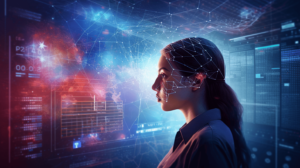I Let AI Run My Business for a Week – Here’s What Happened
Artificial intelligence reshaped my entire perspective on business operations when I decided to integrate it fully into my company for seven groundbreaking days. This bold experiment unleashed unprecedented possibilities that transformed how I view the future of entrepreneurship. The decision to hand over significant control to AI systems wasn’t just about automation – it was about testing the boundaries of what’s possible in modern business management. Like discovering a new continent filled with billions of brilliant minds ready to work tirelessly, this experience opened my eyes to the revolutionary potential of AI in reshaping how we run companies.
We strongly recommend that you check out our guide on how to take advantage of AI in today’s passive income economy.
Table of Contents
The Dawn of AI Integration
The decision to implement AI across my business operations wasn’t made lightly. Traditional businesses rely heavily on human decision-making, but I wondered: what if AI made every single decision? This question led me to conduct a daring experiment that would challenge conventional wisdom about business management. The transformation began with a simple realization – we’re standing at the threshold of a technological revolution comparable to the invention of fire. For the first time in years, I found myself waking up each morning with genuine excitement, eager to witness how AI would handle the day’s challenges. This wasn’t just another technological upgrade; it felt like we had discovered an entirely new way of thinking about business operations.
The implementation process revealed that we’re currently in what could be compared to the AOL dial-up phase of AI – primitive compared to what’s coming, but still revolutionary in its current state. Each morning brought new insights into how AI could transform various aspects of business operations, from basic administrative tasks to complex decision-making processes. The experience was akin to watching the internet evolve from its early days, knowing that we were witnessing just the beginning of something transformative.
The AI Tools That Powered the Experiment
During this transformative week, I implemented various AI tools that fundamentally changed how my business operated. One of the most impactful was an AI agent that prepared comprehensive briefings before every meeting. Thirty minutes before each appointment, I received detailed summaries including attendee backgrounds, previous email communications, and meeting objectives. This system didn’t just save time; it enhanced the quality of every interaction by ensuring I was thoroughly prepared with relevant context and historical data.
The implementation extended far beyond basic meeting preparation. I integrated an AI system for portfolio monitoring that provided real-time updates and analysis of stock performance, offering insights that would typically require a team of analysts to compile. The system could identify trends, flag potential risks, and suggest optimization opportunities with a level of detail and speed that would be impossible for human analysts to match. Additionally, it kept me informed about relevant local events that could impact our business decisions, creating a comprehensive awareness of both market conditions and local business environments.
The Evolution of Administrative Operations
The transformation of administrative tasks proved to be one of the most dramatic changes during the experiment. Traditional assistant work underwent a complete metamorphosis through AI integration. Tasks that previously required hours of human attention became automated, allowing my human staff to focus on more strategic initiatives that required emotional intelligence and creative thinking. The AI systems didn’t just handle basic tasks – they learned and adapted to our specific business needs, creating increasingly sophisticated solutions over time.
One particularly successful implementation was the AI system handling meeting documentation. Using advanced natural language processing, the technology captured detailed notes, generated actionable items, and created comprehensive summaries that were more accurate and detailed than human-generated notes. This single change freed up approximately four hours daily for my executive assistant, enabling her to tackle more complex projects that actually required human insight and creativity. The quality of the documentation improved as well, with perfect recall of every detail and the ability to cross-reference information from previous meetings instantaneously.
Revolutionizing Financial Management
The financial aspect of my business experienced perhaps the most dramatic transformation during this experiment. By exporting our accounting data and training an AI model to analyze it, we created a system that could instantly answer complex financial queries that would typically take days or weeks to research. The AI’s ability to process vast amounts of financial data and identify patterns led to discoveries that would have been nearly impossible to find through traditional analysis.
In one remarkable instance, the AI identified a tax optimization opportunity that resulted in $100,000 in annual savings simply by restructuring an investment’s placement. This discovery highlighted AI’s potential to find patterns and opportunities that might escape even experienced financial professionals. The system could analyze years of transaction data in seconds, identifying trends, anomalies, and opportunities for optimization that would take human analysts months to uncover.
The AI also transformed our approach to financial forecasting and planning. By analyzing historical data, market trends, and various economic indicators, it could generate more accurate predictions about future financial performance. This led to better-informed decision-making about investments, resource allocation, and strategic planning. The system could simulate different scenarios and their potential outcomes, providing a level of insight that would be impossible to achieve through traditional analysis methods.
Transforming Customer Engagement
Customer interaction underwent a significant transformation during this experiment, revealing new possibilities for service delivery and engagement. AI agents handled reservation management for restaurants not available on traditional booking platforms, demonstrating remarkable adaptability in managing complex human interactions. The system could make calls using AI voice technology, handle booking details, manage dietary restrictions, and seamlessly integrate appointments into calendars while maintaining a natural, human-like interaction that customers found comfortable and efficient.
Beyond basic service tasks, the AI systems began to identify patterns in customer behavior and preferences that led to more personalized and effective service delivery. The technology could anticipate customer needs based on historical data and current context, leading to proactive service that exceeded customer expectations. This level of personalization and attention to detail would be impossible to maintain consistently with human staff alone.
The Human Element in an AI-Driven Business
Throughout this experiment, I observed that the real value of AI wasn’t in replacing humans but in enhancing their capabilities and freeing them to focus on tasks that truly required human insight. The technology removed administrative burden, allowing team members to focus on tasks requiring emotional intelligence, creative thinking, and strategic planning. This shift led to increased job satisfaction among staff members who could now focus on more meaningful and challenging aspects of their roles.
The integration of AI also created new roles and opportunities within the organization. Team members who previously spent most of their time on routine tasks began developing skills in AI system management and optimization. This led to the emergence of new positions focused on ensuring AI systems aligned with business goals and maintaining the human element in AI-driven processes.
Future Implications and Business Evolution
This week-long experiment revealed that we’re standing at the threshold of a revolutionary change in business operations. The implications extend far beyond simple task automation – we’re witnessing the emergence of digital employees capable of handling complex responsibilities with remarkable efficiency. The experience demonstrated that approximately 20% of current jobs could be transformed through AI integration, even without further technological advancement.
The experiment also highlighted the importance of preparing for a future where AI integration becomes necessary for competitive survival. Businesses that embrace this transformation early will likely gain significant advantages in efficiency, cost management, and service delivery. However, success will depend on finding the right balance between AI capabilities and human insight.
Lessons for Business Leaders
The experience demonstrated that businesses face a crucial decision point in their evolution. Those who embrace AI integration may see accelerated growth, while those who resist might face increasing competitive challenges. The key lies in understanding AI not as a replacement for human workers but as a powerful tool for augmentation that can enhance every aspect of business operations.
The experiment revealed that successful AI integration requires a strategic approach that considers both technological capabilities and human factors. Business leaders need to prepare their organizations for this transformation by investing in both AI infrastructure and human skill development. The future belongs to organizations that can effectively combine AI efficiency with human creativity and emotional intelligence.
Conclusion
This week-long experiment with AI business integration revealed unprecedented possibilities for operational efficiency and innovation. While we’re still in the early stages of AI adoption – comparable to the dial-up internet era – the potential for transformation is immense. The future of business lies not in choosing between human and artificial intelligence, but in finding the optimal balance between both.
The experience taught me that success in the AI era requires embracing change while maintaining a clear vision of how technology can enhance rather than replace human capabilities. As we move forward, the businesses that thrive will be those that successfully navigate this balance, creating systems that leverage AI’s efficiency while preserving the irreplaceable human elements that drive innovation and creativity. This experiment wasn’t just about testing technology – it was about glimpsing the future of business, and that future is more exciting and full of potential than I could have imagined.

We strongly recommend that you check out our guide on how to take advantage of AI in today’s passive income economy.




